Adora Cheung (part 1): product and honesty curve

Stanford course CS183B: How to start a startup . Started in 2012 under the leadership of Peter Thiel. In the fall of 2014, a new series of lectures by leading entrepreneurs and Y Combinator experts took place:
Second part of the course
First part of the course
- Sam Altman and Dustin Moskovitz: How and why to create a startup?
- Sam Altman: How to form a start-up team and culture?
- Paul Graham: Illogical startup ;
- Adora Cheung: Product and Honesty Curve ;
- Adora Cheung: The rapid growth of a startup ;
- Peter Thiel: Competition - the lot of losers ;
- Peter Thiel: How to build a monopoly?
- Alex Schulz: An introduction to growth hacking [ 1 , 2 , 3 ];
- Kevin Hale: Subtleties in working with user experience [ 1 , 2 ];
- Stanley Tang and Walker Williams: Start small ;
- Justin Kahn: How to work with specialized media?
- Andressen, Conway and Conrad: What an investor needs ;
- Andressen, Conway and Conrad: Seed investment ;
- Andressen, Conway and Conrad: How to work with an investor ;
- Brian Cesky and Alfred Lin: What is the secret of company culture?
- Ben Silberman and the Collison Brothers: Nontrivial aspects of teamwork [ 1 , 2 ];
- Aaron Levy: Developing B2B Products ;
- Reed Hoffman: On Leadership and Managers ;
- Reed Hoffman: On the leaders and their qualities ;
- Keith Rabois: Project Management ;
- Keith Rabua: Startup Development ;
- Ben Horowitz: Dismissal, promotion and reassignment ;
- Ben Horowitz: Career advice, westing and options ;
- Emmett Shire: How to conduct interviews with users;
- Emmett Shire: How to talk to users in Twitch ;
- Hossein Rahman: How hardware products are designed in Jawbone;
- Hossein Rahman: The Design Process at Jawbone.
Thank you for inviting me. Today I am going to talk about how to go from scratch to acquiring a large number of customers. I believe that you already have a lot of great ideas, and you are thinking about what your next step will be.
')
I prepared the text of the speech this morning and almost everything I’m talking about is based on the mistakes I made in the past. So, as Sam noted, I came to Y Combinator in 2010: I doubted for three years, gave up and started all over again, and I determined what I won’t do if I launch a new project after Homejoy. Most of the tips are the results of failures, and I’ll just tell you what you shouldn’t do and summarize what you need to do.
I must say that you should not take all the tips as a guide to action, as each business is different from the others. You are different from me, and I - from you, consider this.

When you start a startup, you should have a large amount of time at your disposal to concentrate on it. I'm not saying that you should skip classes or quit your job, I say that you should have a lot of time to devote to the idea and dive into it with your head, look for exits and try to solve problems. For example, if you study, it would be better to set aside one or two days a week to work on an idea than to spend two hours here and there every day.
Since our course is technical, it is possible to draw a parallel with programming. The ability to fully concentrate and immerse yourself in work is very important due to the large number of distractions.
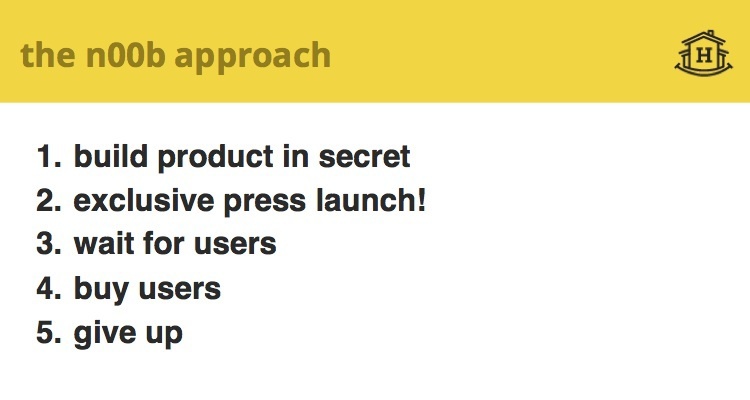
As I mentioned, when I wrote down all of this, I thought that most people, when creating a startup, do something wrong. The newbies think, “I have a great idea, so I won't tell anyone about it. I will work, work, work, and then, maybe, I will tell about it to one or two people, and then post it on TechCrunch or anywhere else, and I will have many clients. ”
But what actually happens is due to the lack of feedback. Maybe you will attract many visitors to your site, but none of them will stay there for a long time, and this is because you did not work with them properly. If you are lucky enough and have a bank account, you can “buy” customers, but they will eventually leave and you will give up.
This is a kind of vicious circle. Once I did that, and then I repeated my mistake while I was at YC. When I went through the YC school, I didn’t even launch the product. I did not publish the release on TechCrunch, but this is definitely to be done. You should not fall into such a loop, because it will not end in anything good.
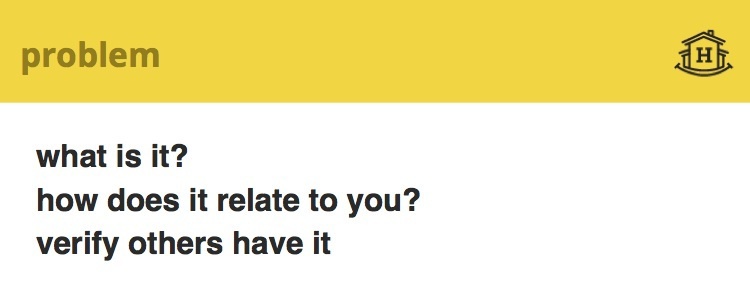
The next point is: you have an idea, and you should seriously think about what problem it actually solves. What is the problem? You should be able to describe the problem you are trying to solve in one sentence. And then think: “Does this problem relate to me? Does she really bother me? And again: “Let this be a problem that worries me, but does it worry others?” This can be checked by interviewing others.
One of the biggest mistakes I made affects me and my co-founder, my brother. In 2009 or 2010, we founded the company and named it Pathjoy. We pursued two goals. The first was to create a company that can make people truly happy, the second is to create a company that would be very, very effective.
A good solution is to simply create a big company. The problem we solve is how to make people happier. At first we came to the question: who are the people who make people happier? And they decided that these were personal growth instructors and therapists. Obviously, we needed to create a platform for personal growth trainers and therapists.
As a result, when we started using our own product - and we are not cynical, in any case - it turned out that therapists and instructors are not the people we would like to deal with. Everything that we created was useless for us. So, we did not try to solve our own problem, we were not genuinely passionate about what we were doing, and yet we spent almost a year trying to implement this project. And if you start from scratch and think about it before embarking on the creation of any product, you, it seems to me, will avoid a big headache and will not do what you don’t want to do.
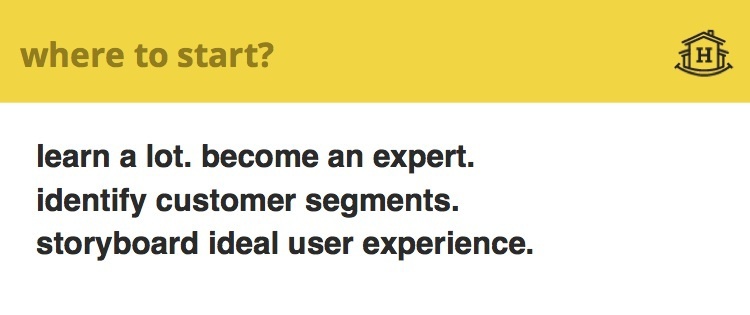
Let's say that you have a problem and you are sure of it, so how do you start and how do you think it will be resolved? First of all, you should think about the industry in which you are going to do business. Whether it is a large industry or even just huge, you have to immerse yourself in it. There are several ways to do this.
One way is to briefly become a cog in a large production machine. This may seem somewhat illogical, because it is believed that if you really want to bring something new to the industry, you should not dive into it for a long time.
Those who spend 20 or 30 years working in one place, follow the usual routes, are satisfied with how things are going, and never think that their work may be ineffective or things that can “break” the usual pattern . However, as a beginner, you, plunging into the industry, have to spend only one or two months just to understand the component parts of this system and the principle of their work. Because, going into details, you start to notice that you can use what works inefficiently and costs too much, and how to save money on it.
As an example: Homejoy story
When we launched Homejoy, we started with the cleaning industry and decided to work as cleaners ourselves. We began to clean the house and very quickly discovered that, as cleaners, we are so-so. As it turned out, we need to learn more about cleaning, so we went and bought books that helped, but quite a bit. We've learned more about cleaning supplies, but this is akin to playing basketball: you can read and learn the rules, but you won’t play better if you don’t train to throw the ball in the ring.
And we decided that one of us would go and learn how to clean up. Or, in any case, learn from a professional. Surprisingly, we began to look for work in cleaning companies. Of course, it's great that I learned how to clean up in just a couple of weeks that I spent at work, but even better, I learned a lot about the work of local cleaning companies. This helped me understand why local cleaning companies cannot grow to today's sizes Homejoy. This is because they are rather old-fashioned and do many things inefficiently. For example, customer registration and optimization of the schedule of cleaners are extremely inefficient there.
And we decided that one of us would go and learn how to clean up. Or, in any case, learn from a professional. Surprisingly, we began to look for work in cleaning companies. Of course, it's great that I learned how to clean up in just a couple of weeks that I spent at work, but even better, I learned a lot about the work of local cleaning companies. This helped me understand why local cleaning companies cannot grow to today's sizes Homejoy. This is because they are rather old-fashioned and do many things inefficiently. For example, customer registration and optimization of the schedule of cleaners are extremely inefficient there.
If your situation is similar to mine, and in the business you want to do, there is an element of service delivery, you must learn to provide these services yourself. If your idea is related to the restaurant business, you should become a waiter, if it is related to drawing - an artist: you need to look at your clients from all possible sides of the business you are trying to build.
Among other things, you should be slightly "obsessed" in your business. You need to be obsessed enough to seek out everything that others in your industry are doing. This also includes compiling a list of all potential competitors and similar companies. You should click on each link and read each article about them from the first in search results and the thousandth.
I found all potential competitors, large and small, and if they were public companies, I read their quarterly financial statements and attended their newsgroups. You already know most of this, and you will not extract anything important for yourself, but among all this information, you will come across insights with a certain frequency. But you will not be able to find them until you yourself go through all this and put this information in your head.
You must become an expert in your business. When you start working on your project, no one should have doubts that you are an expert, then people will trust you.
Next, you will need to determine the target audience. Ideally, you should create a product or service that everyone will use. But in real life, at first you just want to reach a certain part of potential customers in order to further optimize your business for them. It’s all about focusing on the target audience, whether you serve teenage girls or moms of the football team in the restaurant: you should be able to focus on their needs.
And last, before creating a product or starting to write program code, you must describe the intended UX: how the user solves his problem with your help. It is not enough to simply create a website, you need to take care and that the buyers know about you. It could be an advertising campaign or just chatting with those who could visit your site and learn more about you.
- What will be written on the site, how will you communicate with customers when they register or purchase a service?
- What do they actually get from your service or product?
- When they stop using the product or service, should they leave feedback or comments?
You have to go through all this and imagine in your head what the perfect user experience will be with your product. Then write it down, use it when writing code, and it is from this point that you start creating the product.
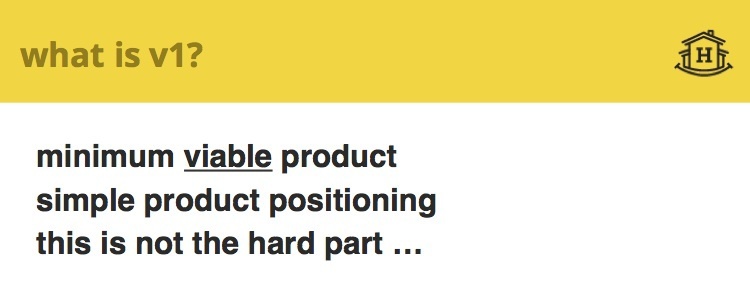
So, you have an idea, you kind of know the target audience that you want to reach, and you know everything about your industry: what do you need to do next? You start creating your product. Today, most say: "You must create a minimally viable product."
I emphasized “viable” because I believe that many people miss this part and immediately start creating “additional options” of the product, which is badly perceived by customers. The minimum viable product is the smallest set of functions that must be implemented to solve the problem. I think if you look at already working projects, you will understand it very quickly. But again, you have to speak with clients, you have to follow what already exists in your area, and what you create must meet current needs of the audience.
Also, before offering something to the customer, you must deal with the positioning. By this I mean that when you approach a person, you should be able to say: “See, this thing does this, this and that” in one sentence. For example, at Homejoy, we started with something very complicated. We were an online platform for home-based services, their list began with a cleaning service. Then you could choose one, the other, the third. The entire description stretched over several paragraphs.
When potential customers came to our site, they became bored after the first few offers. So we realized that we need a short slogan. Creating a slogan is a very important component. He describes the functional virtues of what you do.
When you will further shape your brand, you should be able to describe the benefits of the product in terms of the user's emotions. But if you start from scratch, you need to tell them what they will get as a result. After we changed our positioning and began to tell us that we were doing cleaning for $ 20 per hour, our offer immediately became clear to users, and we had clients.
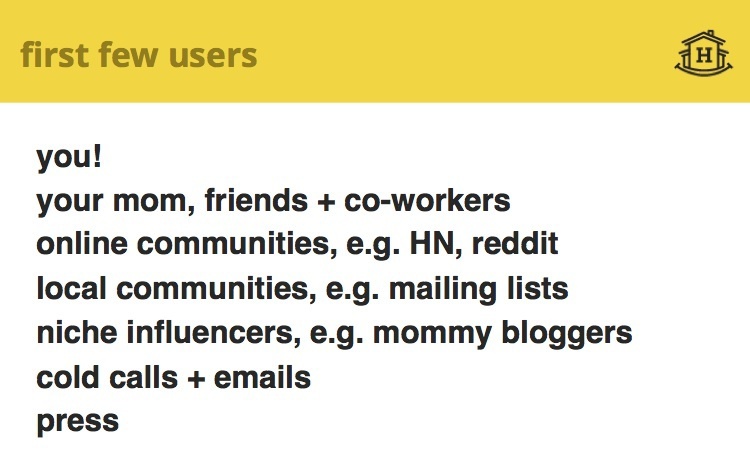
So, you figured out what MVP is: how can you now attract first customers? The first few users should obviously be the people with whom you are familiar. You and your co-founder should use the product; you should involve your parents, friends, and colleagues. This will help get even more feedback.
I have compiled a list of the most obvious places to go, depending on what you are selling. You can choose one of them. Use online communities: Hacker News now has a block Show HN - this is a great place for this kind of stuff. Especially if you create tools for developers or something like that. Work with local communities if you produce consumer goods. There are many local community mailing lists whose members can become opinion leaders regarding your product. In particular, the community for parents - they may also be involved.
At Homejoy we tried all of these options.
We used our services on our own - this is normal. We were the only cleaners, so it was pretty easy for us. Our parents lived in Milwaukee, and our office was located in Mountain View, so we could not go to them. Friends and colleagues were scattered in different cities - someone lived in San Francisco, someone else else, so we could only count on a few of them.
It turned out that we were at a deadlock, because at first we could not convince enough people to use our services. What we did: we were in Mountain View, and some probably know that street bazaars are open on Castro Street in the summer. We went out and literally chased people and tried to get them to sign up for cleaning. Almost everyone said "no", until one day everything changed due to the weather. It was a very hot and damp day, and we noticed that on such days, more and more people stumble to the benches with food and drink.
We realized that we needed to be right in the middle of the crowd, so we stuck the bottles of water, cooled it, and started handing them out. And people just reached out to us. Having done this, I realized that people began to sign up for cleaning only out of gratitude. But as it turned out, they did not refuse our services. Well, some refused, but most took advantage of our help. I felt that this was a way out of the situation - let me then have to get out of these people, but we decided our problem.
It turned out that we were at a deadlock, because at first we could not convince enough people to use our services. What we did: we were in Mountain View, and some probably know that street bazaars are open on Castro Street in the summer. We went out and literally chased people and tried to get them to sign up for cleaning. Almost everyone said "no", until one day everything changed due to the weather. It was a very hot and damp day, and we noticed that on such days, more and more people stumble to the benches with food and drink.
We realized that we needed to be right in the middle of the crowd, so we stuck the bottles of water, cooled it, and started handing them out. And people just reached out to us. Having done this, I realized that people began to sign up for cleaning only out of gratitude. But as it turned out, they did not refuse our services. Well, some refused, but most took advantage of our help. I felt that this was a way out of the situation - let me then have to get out of these people, but we decided our problem.
One of the startups of the last set of YC, the founders of which were selling packaging goods for transportation, did the following: they searched the post offices for those who wanted to send a package, took someone out of the line, offered this person to use their product and then sent parcel for him. So, you just need to find crowded places. Your customer turnover will be very small, but to move from zero to one, three customers, and so on, such things just need to be done.
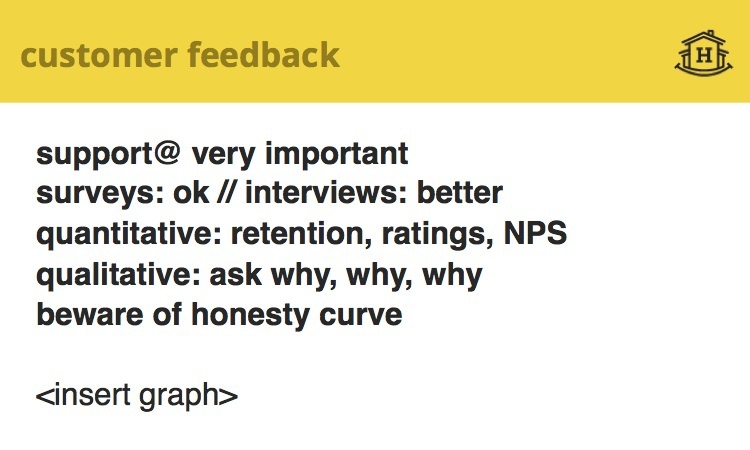
Now you have customers, so what do you do with them? First of all, you need to make sure that people have a way to contact you. Ideally, this is a phone number, and if you register it, you should make sure that you have voice mail so that you do not have to pick up the phone for each call.
In any case, the opportunity to receive feedback is good, but in fact you have to communicate, talk with customers. Get up from your desktop, go and do it. At first glance, this is not easy - it is really hard, exhausting work, but this is how you will get the most complete feedback on your project. And this is how you will understand which options or services you need to completely change, which ones to remove or add.
Another way to get feedback is to send interviewers to conduct a survey among people who have used the product. This is in the order of things, but most often people agree to leave reviews only if they love you very much or hate you a lot. And you will never get a more balanced view.
To collect additional information, you need to meet with the client. I saw people who met with clients and interrogated them, both in the laboratory or at the court of the Inquisition - this will not give you good results. In fact, you should build a conversation, try to get to know them, make them feel comfortable.
You must gain their trust to improve anything. I realized that bringing someone to a bar, for example, is a great way to achieve such a confidential atmosphere. I'm not sure that all of you are old enough for such maneuvers, but you can invite them at least for a cup of coffee.
Another indicator that you should track is how things are going from a perspective point of view. The best way to do this is to fix the number of your customers. The number of those who came to you during the day, the number of people who will return tomorrow, the day after tomorrow, and so on. Over time, you usually look at the number of visitors and notice that those who have come today are returning over the next month, again and again.
The main problem that arises with this parameter is that data collection can take forever, but sometimes you don’t have a month or two or three to calculate. Therefore, the most effective indicator is to collect reviews and build ratings. This may be a tally of reviews in which users rate you 5 out of 5 or 4 out of 5 or collecting information on consumer loyalty index (NPS) - for this you simply ask users to rate on a scale from 0 to 10 the chance that they will recommend you to your friends, and calculate NPS.
Over time, you will see that as the number of new features increases, both the number of reviews and the number of customers increase. This means that you are doing everything right. If this does not happen, then something is wrong with you. If everything stays at the same level, perhaps this means that you need to go and find out what new features you need to implement.

Another thing to take into account is the honesty curve. Some people will just lie to you. See, there is your mom, your friends, friends of friends, and absolutely random people. Your mother will use your product and will be proud of you anyway, so she will be honest with you. Your friends will be honest enough with you and will give you recommendations, because they care about you - if your product is free . And then you will receive more and more random reviews by nature from those who know nothing about you. These are people who are not at all interested in wasting their time and energy on recall. So take this into account.

Let's say now that this is a paid product. If we are talking about a paid product, the opinion of the mother will be in last place, here at the bottom. She will just lie to you and say that the product is wonderful. But then the schedule goes something like this (draws an increasing schedule). Your friends will support you and give you useful advice, but in reality the opinion of those strangers will be the most important for you, because if they do not understand what they are paying for, they will definitely tell you about it: their money is at stake .
This is another way to say that you will receive the most effective reviews and comments in the case of working with a paid product. This does not mean that you should do it from the very beginning. This means that if you are going to create a product for which you ultimately need to pay, be it software, hardware or anything else, then you need to come as quickly as possible to the point where you really need to pay. Because from now on you will be able to create more useful functions, which will attract more people willing to pay.
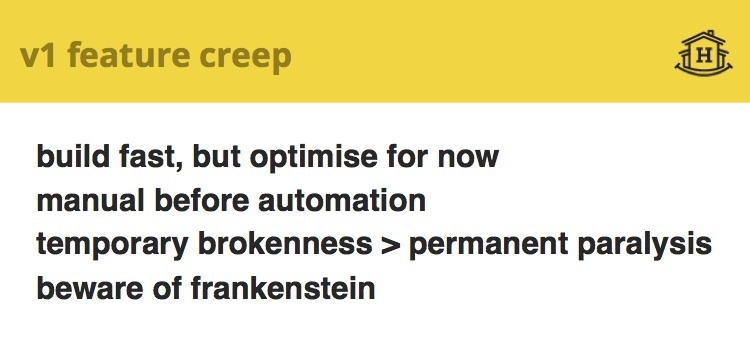
So, you get feedback, and what do you do before the official launch of the project? You always want to do everything quickly, constantly improving the project at the growth stage. At the moment, you can work with 10 clients - there is no point in trying to add features for another 10 million people. You need to optimize the project for the next growth stage from 10 to 100 clients. Add features that you really need and move on. I learned from my own experience the full significance of this approach to scaling.
You should not try to automate everything and create software to control robots that could do everything for you. To figure out what you need to do, you first need to start working on these tasks yourself.
for example
When we started working with professional cleaners, we tried to ask them a lot of questions over the phone, and then continued to ask them questions personally. After they carried out the test cleaning and only then, if the quality of their cleaning satisfied us, they began to cooperate with our platform. According to the results of all these surveys, we hired only 3-5% of candidates.
Over time, we realized that certain questions we asked are good indicators of whether a person can work through our platform — we could determine this by collecting data and viewing the online form that the candidate filled out. Only after that we created an online application, with the help of which the candidates applied, and then, if necessary, asked them a few questions during a personal interview.
Over time, we realized that certain questions we asked are good indicators of whether a person can work through our platform — we could determine this by collecting data and viewing the online form that the candidate filled out. Only after that we created an online application, with the help of which the candidates applied, and then, if necessary, asked them a few questions during a personal interview.
If you try to automate some tasks too quickly, you can get into an unpleasant situation when you can not quickly respond to new data and develop processes iteratively - just as we gradually moved from personal questions to creating an application.
The next point is that temporary inadequacy is better than permanent paralysis. By this I mean that at this stage it is useless to engage in bringing the product to perfection. When you go to a new level of growth, what you tried to polish in the previous step ceases to matter. Therefore, creating something, do not worry about all extreme cases, work on the most likely scenarios, starting from an understanding of who your primary user is. As your company grows, the volume of such extreme cases will only get bigger and bigger.
Finally, be wary of the “Frankenstein approach”: the fact that you collect feedback and ideas from users is certainly good, and your first desire in this regard will be an attempt to satisfy them all, do all that they ask, and show them to them the next day. changes and make them all happy.
Definitely, it is necessary to listen to user feedback, but if someone advises you to do something, it is not necessary to run and fulfill this request. What you really need is to get to the bottom of the point: why, in reality, the user asks you about certain changes. As a rule, what your audience offers you is far from the most optimal solutions.
What they really want to convey to you is either that they have problems in using your product, or that the product basically does not solve any of their problems, because of which they may not be ready to pay for him Figure this out before lumping up all the offers from your users, for which, in essence, you don’t see a real problem.
So, you have a product that you are ready to supply - many at this moment continue to “finish” it and delay the release. I believe that the very idea of remaining in the mode of secrecy and improving the product to infinity is, in fact, an imitation, which is “cheaper” than innovation in terms of money and resources spent.

I believe that everyone should generally understand that if your idea is really good - it does not matter at what stage the release will occur - someone will definitely try to use it and make their product as fast as they can in order to surpass you. It makes no sense to reject the opportunity to acquire potential users and get a lot of feedback from them simply because you are feeling paranoid and are afraid that someone will do it for you.
I can not bear to repeat this, but it is these sentiments that I see among the founders of the companies - I myself went through something similar. I think that unless you create something that requires multi-million investments at the start, there is absolutely no point in waiting for something and delaying the release.
[ The second part of the translation of the Adora lecture ]
Source: https://habr.com/ru/post/243493/
All Articles